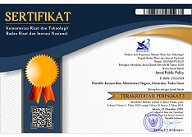Efficiency Analysis of Central Government Transfer Funds to the Regions Income Inequality
Abstract
Full Text:
PDFReferences
Akita, T., & Miyata, S. (2008). Urbanization, educational expansion, and expenditure inequality in Indonesia in 1996, 1999, and 2002. Journal of the Asia Pacific Economy, 13(2). https://doi.org/10.1080/13547860801923558
An, N., Wei, W., Qiao, L., Zhang, F., Christie, P., Jiang, R., Dobermann, A., Goulding, K. W. T., Fan, J., & Fan, M. (2018). Agronomic and environmental causes of yield and nitrogen use efficiency gaps in Chinese rice farming systems. European Journal of Agronomy, 93(May 2017), 40–49. https://doi.org/10.1016/j.eja.2017.11.001
Andriani, R. N. R., & Wahid, N. N. (2018). Pengaruh Pendapatan Asli Daerah dan Dana Perimbangan Terhadap Kemandirian Keuangan Daerah. Jurnal Akuntansi, 13(1), 30–39.
Baker, P., Hone, T., Reeves, A., Avendano, M., & Millett, C. (2019). Does government expenditure reduce inequalities in infant mortality rates in low- and middle-income countries?: A time-series ecological analysis of 48 countries from 1993 to 2013. Health Economics, Policy, and Law, 14(2), 249–273. https://doi.org/10.1017/S1744133118000269
Banerjee, A. V., & Mullainathan, S. (2008). Limited attention and income distribution. American Economic Review, 98(2), 489–493. https://doi.org/10.1257/aer.98.2.489
Bonet, J. (2006). Fiscal decentralization and regional income disparities: Evidence from the Colombian experience. Annals of Regional Science, 40(3). https://doi.org/10.1007/s00168-006-0060-z
Booth, A., Purnagunawan, R. M., & Satriawan, E. (2019). Towards a Healthy Indonesia? Bulletin of Indonesian Economic Studies, 55(2), 133–155. https://doi.org/10.1080/00074918.2019.1639509
Chandio, A. A., Jiang, Y., Gessesse, A. T., & Dunya, R. (2018). The Nexus of Agricultural Credit, Farm Size and Technical Efficiency in Sindh, Pakistan: A Stochastic Production Frontier Approach. Journal of the Saudi Society of Agricultural Sciences, 1–7. https://doi.org/10.1016/j.jssas.2017.11.001
Chongvilaivan, A., & Kim, J. (2016). Individual Income Inequality and Its Drivers in Indonesia: A Theil Decomposition Reassessment. Social Indicators Research, 126(1). https://doi.org/10.1007/s11205-015-0890-0
Djohan, S., Hasid, Z., & Setyadi, D. (2016). Government Expenditure as Determinants of Economic Growth and Income Inequality of Inter-Province of the Islands in Indonesia. Journal of Economics and Sustainable Development, 7(22), 148-158–158.
Guiga, H., & Rejeb, J. Ben. (2012). Poverty, growth, and inequality in developing countries. In International Journal of Economics and Financial Issues (Vol. 2, Issue 4, pp. 470–479).
Heryanah, H. (2017). Kesenjangan Pendapatan Di Indonesia: Berdasarkan Susenas 2008, 2011 Dan 2013. Jurnal BPPK : Badan Pendidikan Dan Pelatihan Keuangan, 10(2), 16. https://doi.org/10.48108/jurnalbppk.v10i2.26
Huang, B., & Morgan, P. J. (2018). MIDDLE-INCOME TRAP IN ASIA Avoiding the Middle-Income Trap in Asia. Asian Development Bank Institute.
Jamal, A., Muhammad, S., Masbar, R., & Aliasuddin. (2015). Did Indonesian political, and economic reform reduce economic growth disparities among regions? DLSU Business and Economics Review, 25(1), 81–94.
Miranti, R., Vidyattama, Y., Hansnata, E., Cassells, R., & Duncan, A. (2013). Trends in Poverty and Inequality in Decentralising Indonesia. 148, 1–103. http://dx.doi.org/10.1787/5k43bvt2dwjk-en
Mishra, A., & Agarwal, A. (2019). Do infrastructure development and urbanization lead to rural-urban income inequality? Evidence from some Asian countries. International Journal of Sustainable Economy, 11(2), 167–183. https://doi.org/10.1504/IJSE.2019.099054
Nawawi, A. (2021). Analisis Respon Belanja Apbd Terhadap Transfer Tidak Bersyarat Dari Pemerintah Pusat: Studi Kasus Seluruh Kabupaten/Kota Di Provinsi Jawa Barat, Jawa Tengah, Jawa Timur, Banten, Dan Daerah Istimewa Yogyakarta Tahun 2018-2020. Jurnal Anggaran Dan Keuangan Negara Indonesia, 3(1), 41.
Pilat, J. J., & Morasa, J. (2017). Analisis Rasio Keuangan Anggaran Pendapatan Dan Belanja Daerah (Apbd) Kota Manado Untuk Menilai Kinerja Keuangan Pemerintah Kota Manado Tahun Anggaran 2011 - 2015. Jurnal Accountability, 06, 45–56.
Putri, N. putu V. S., & Natha, I. K. S. (2014). Pengaruh Pendapatan Asli Daerah , Dana Alokasi Umum dan Belanja Modal Terhadap Ketimpangan Pendapatan. In E-Jurnal Ekonomi Pembangunan Universitas Udayana (Vol. 4, Issue 1, pp. 41–49).
Shin, K., Lee, D., Shin, K., & Kim, E. (2018). Measuring the efficiency of U.S. pharmaceutical companies based on open innovation types. Journal of Open Innovation: Technology, Market, and Complexity, 4(3). https://doi.org/10.3390/joitmc4030034
Tsionas, M. G. (2017). The profit function system with output- and input-specific technical efficiency. Economics Letters, 151, 111–114. https://doi.org/10.1016/j.econlet.2016.12.020
Wahyuni, H. (2004). Is There a Link Between Increased Growth? 1, 1–9.
Waluyo, J. (2004). Ekonomi Pembangunan Hubungan Antara Tingkat Kesenjangan Pendapatan Dengan Pertumbuhan Ekonomi: Suatu Studi Lintas Negara. Jurnal Ekonomi Pembangunan Kajian Ekonomi Negara Berkembang, 1–20.
Wardhana, A., Juanda, B., Siregar, H., & Wibowo, K. (2013). Dampak Transfer Pemerintah Pusat Terhadap Penurunan Ketimpangan Pendapatan Di Indonesia. Sosiohumaniora, 15(2), 111. https://doi.org/10.24198/sosiohumaniora.v15i2.5737
Wibowo, T. (2016). Ketimpangan Pendapatan dan Middle Income Trap Income Inequality and Middle Income Trap. Kajian Ekonomi Keuangan, 20(2), 111–132. http://fiskal.kemenkeu.go.id/ejournal
Xu, Y., Zhang, B., & Zhang, L. (2018). A technical efficiency evaluation system for vegetable production in China A technical efficiency evaluation system for vegetable production in China Abstract : With the increasing demand for food worldwide , it has attracted increasing. Information Processing in Agriculture, May. https://doi.org/10.1016/j.inpa.2018.05.001
Yasni, R., & Yulianto, H. (2020). Peran Belanja Modal Dan Belanja Bantuan Sosial Pemerintah Daerah Terhadap Ketimpangan Pendapatan Di Indonesia. Substansi: Sumber Artikel Akuntansi Auditing Dan Keuangan Vokasi, 4(1), 39–63. https://doi.org/10.35837/subs.v4i1.819
Yusuf, A. A. (2013). Working Paper in Economics and Development Studies Twenty Years Of Expenditure Inequality; in For Economics and Development Studies CEDS 2 King’s International Development Institute , King ’ s College London. 6.
Yusuf, A. A., & Halim, P. R. (2021). Inequality and structural transformation in the changing nature of work: The case of Indonesia (2021/81, Issue May 2021). https://doi.org/https://doi.org/10.35188/UNU-WIDER/ 2021/019-1
Zewdie, M. C., Moretti, M., Tenessa, D. B., Ayele, Z. A., Nyssen, J., Tsegaye, E. A., Minale, A. S., & Van Passel, S. (2021). Agricultural technical efficiency of smallholder farmers in Ethiopia: A stochastic frontier approach. Land, 10(3), 1–17. https://doi.org/10.3390/land10030246
DOI: https://doi.org/10.35308/akbis.v7i2.7571
Refbacks
- There are currently no refbacks.





